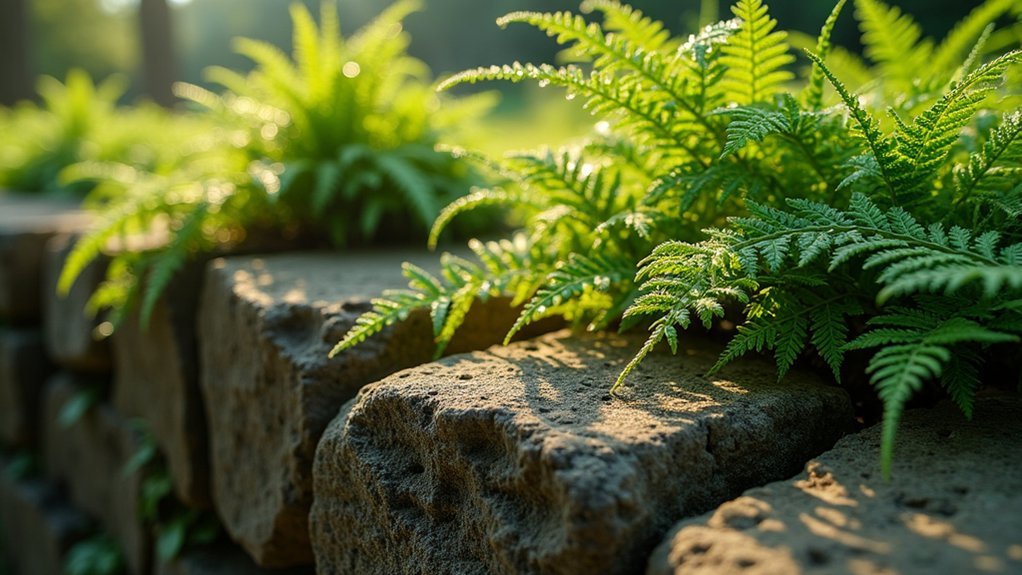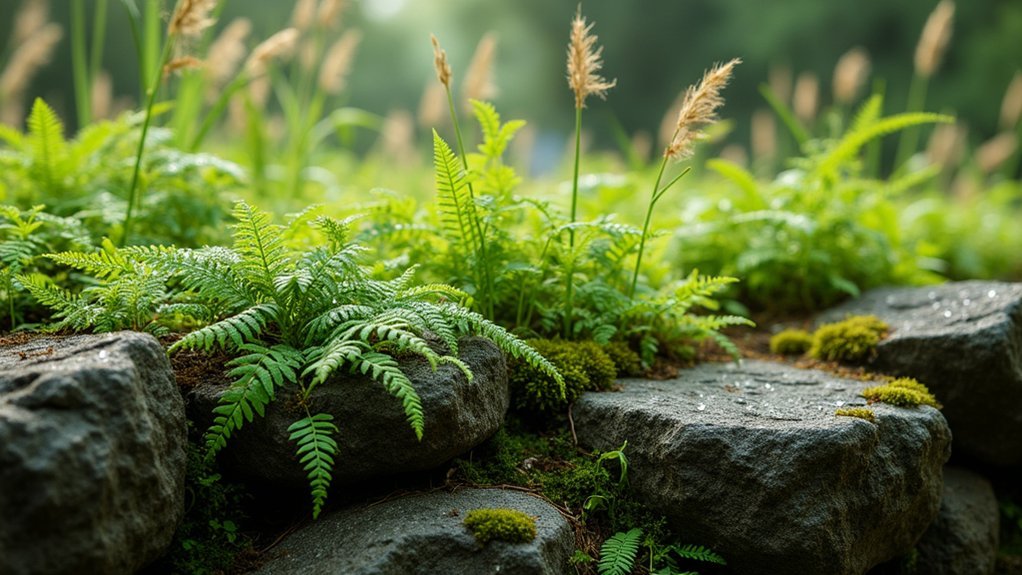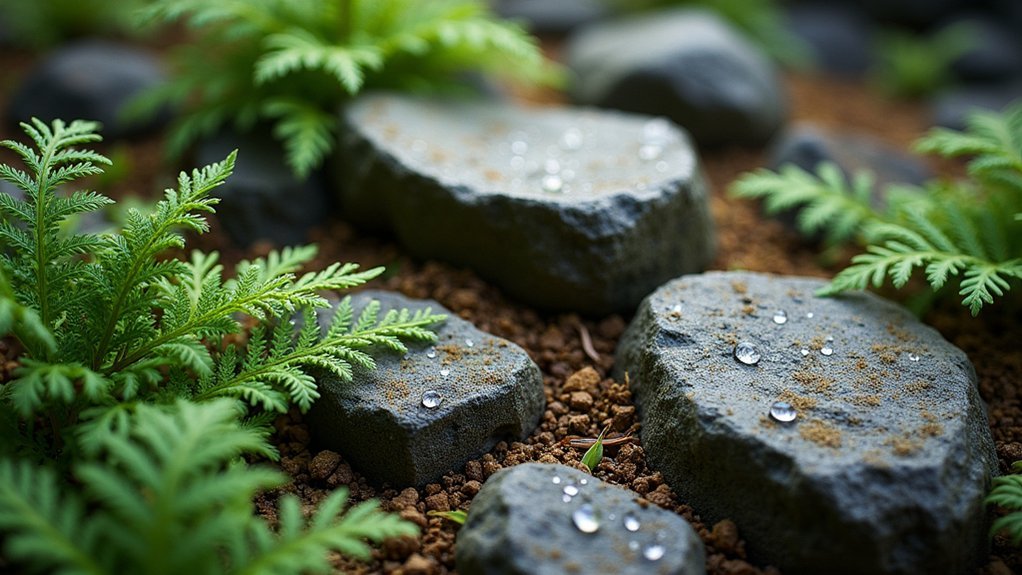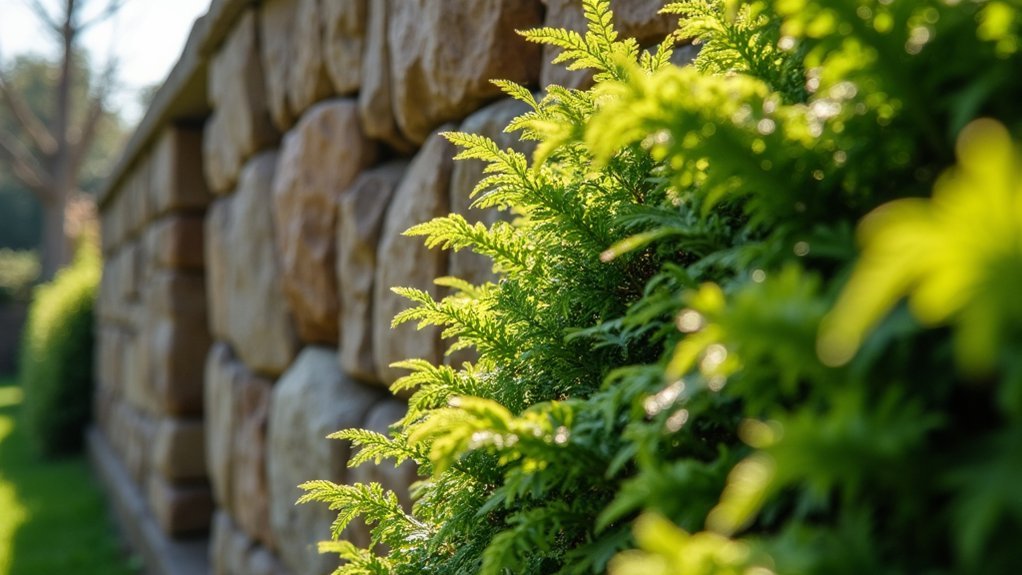Stone-fern barriers work so effectively because they create a symbiotic relationship that benefits both elements. The stones provide structural stability, prevent erosion, and create microhabitats while absorbing and releasing heat. Meanwhile, ferns retain moisture, enhance soil health, and support biodiversity. Together, they form resilient ecosystems that adapt to various climates while requiring minimal maintenance. This natural pairing offers both practical protection and aesthetic appeal throughout all seasons.
What Makes Stone-Fern Barriers So Effective?

While traditional landscaping solutions often fall short in challenging environments, stone-fern barriers excel by combining complementary elements into a single, powerful system.
You’ll find that natural stone provides the structural foundation, preventing erosion and creating stability that withstands harsh weather conditions.
Ferns contribute essential biological benefits to this partnership. They retain moisture, improving humidity levels around the barrier and enhancing soil health.
When you place ferns alongside stone, you’re creating microhabitats that support biodiversity, especially in shaded areas where these plants naturally thrive.
The layered design allows water to drain effectively, preventing damaging moisture buildup.
By choosing native ferns, you’re supporting local ecosystems while the stone offers protection.
Native ferns strengthen your local ecosystem while sturdy stone elements provide crucial protection for these beneficial plants.
This symbiotic relationship creates a sustainable solution that works with nature rather than against it.
The Historical Significance of Stone-Fern Combinations
Before modern landscaping materials emerged, stone-fern combinations served as ingenious solutions across rural communities worldwide.
You’ll find these boundaries particularly prevalent in New England, where stone walls paired with native fern varieties became symbolic of agricultural heritage and craftsmanship.
Traditional construction techniques involved carefully stacking local stones without mortar, creating structures that could withstand seasonal changes.
Farmers strategically planted ferns alongside these walls, recognizing their practical benefits for moisture retention and soil conservation.
What’s remarkable is how these barriers balanced functionality with natural beauty.
The enduring stone provided permanence while ferns added living texture that changed with seasons.
These combinations weren’t merely property markers—they represented a sustainable approach to land management, showcasing our ancestors’ understanding of working harmoniously with available materials.
Ecological Benefits of Integrated Natural Barriers

Stone-fern barriers create a unique moisture management symbiosis where stones collect and slowly release water that ferns utilize during dry periods.
You’ll notice these integrated structures form biodiversity preservation zones that support complex mini-ecosystems, from microorganisms in the soil to birds nesting among the fronds.
The strategic placement of these natural barriers can transform ordinary landscapes into thriving wildlife corridors, connecting fragmented habitats that would otherwise remain isolated.
Moisture Management Symbiosis
Because nature thrives on balance, the integration of stones and ferns creates a remarkable ecological partnership that benefits entire garden ecosystems. This symbiotic relationship works at every step of the moisture cycle – ferns absorb and retain water while stones facilitate proper drainage.
You’ll find that smaller varieties of ferns match every landscaping need while working beneath the surface to prevent water damage to your stone structures. The ferns utilize available moisture that might otherwise accumulate, while stones channel excess water away from sensitive areas.
This natural partnership greatly reduces your need for artificial irrigation. As the ferns help retain soil moisture and stones prevent water logging, you’re creating a self-regulating system that promotes sustainable gardening while protecting against erosion and supporting biodiversity in your garden space.
Biodiversity Preservation Zones
When properly installed, stone-fern barriers transform ordinary garden spaces into thriving biodiversity preservation zones that nurture countless species.
These integrated barriers create crucial microhabitats that enhance your garden’s ecosystem resilience while supporting diverse plant and animal communities.
The stone structures provide shelter and nesting sites for small wildlife, while the ferns stabilize soil and prevent erosion. Together, they protect against harsh weather conditions and improve water retention in the surrounding soil.
You’ll notice increased species richness as these natural sanctuaries attract and sustain local fauna.
Additionally, the diverse plant species within these zones boost pollinator activity, which is essential for ecological reproduction and agricultural productivity.
Structural Integrity: How Stones Support Fern Growth
The symbiotic relationship between stones and ferns creates a remarkably effective barrier system that benefits both elements. When you construct these barriers, you’re utilizing the stones’ weight and arrangement to provide essential anchorage for fern roots, allowing them to establish firmly even in challenging soil conditions.
Stones serve multiple functions beyond mere support. They’ll absorb daytime heat and release it gradually at night, creating a microclimate that regulates temperature and moisture levels perfectly for fern development.
Stones create living thermostats for ferns, absorbing day’s warmth and releasing it nightly for optimal microclimate conditions.
You’ll notice improved drainage and aeration around your ferns thanks to the stones’ natural texture and composition.
Additionally, your ferns will benefit from nutrients leaching from the stones themselves, enriching the surrounding soil. This nutrient exchange promotes more robust growth while the overall structure prevents erosion and maintains ideal moisture levels.
Moisture Management in Stone-Fern Systems

Beyond their structural advantages, stone-fern barriers excel at water regulation—a vital factor in their effectiveness and longevity.
These systems utilize a rain screen design that creates necessary air gaps between building materials, preventing trapped moisture that often leads to deterioration.
When you pair EMC-3639 drainage mats with natural stone and ferns, you’re creating vertical channels that facilitate gravity-driven water drainage.
This design maintains essential air gaps over building paper or house wrap, supporting drying mechanisms that reduce masonry failures.
You’ll find WEEPs and moisture diverters strategically incorporated to redirect water away from vulnerable areas.
This all-encompassing approach doesn’t just prevent water resistance deterioration in materials—it directly addresses the growing challenge of moisture-related failures in modern construction practices.
Climate Adaptability Across Different Regions
You’ll find stone-fern barriers remarkably resilient in Arctic conditions, where the stone components insulate against freezing while specialized cold-hardy ferns survive harsh winters.
In tropical environments, these systems excel by balancing excess humidity through the stone’s drainage properties while ferns thrive in the consistent moisture levels.
Even desert installations demonstrate impressive heat resistance, as the stones create cooling microclimates and retain precious moisture that sustains drought-adapted fern varieties.
Arctic Endurance Capabilities
While many barrier systems fail under extreme cold conditions, stone-fern barriers demonstrate remarkable resilience in arctic environments where temperatures regularly plummet below -40°F. The innovative combination of dense stone and cold-hardy ferns creates a structural defense that manages moisture effectively, preventing the destructive frost heave that damages conventional barriers.
You’ll find these systems particularly valuable in northern latitudes where limited sunlight poses challenges for vegetation. The ferns’ ability to thrive in low-light conditions guarantees year-round functionality.
| Arctic Challenge | Stone-Fern Solution |
|---|---|
| Extreme cold (-40°F) | Temperature-resistant materials |
| Limited sunlight | Low-light adapted ferns |
| Harsh winds | Stable stone structure |
| Frost heave risk | Superior moisture management |
These barriers don’t just protect—they enhance local ecosystems by providing habitat for cold-adapted wildlife, contributing to biodiversity even in harsh conditions.
Tropical Humidity Response
Stone-fern barriers don’t just excel in frigid environments—they also perform exceptionally well in tropical climates where high humidity presents different challenges.
These structures thrive in regions with at least 50% humidity, creating a perfect symbiotic relationship between materials.
You’ll find that the stone component provides essential drainage in heavy rainfall, while simultaneously helping to establish a microclimate that supports fern growth.
The ferns’ dense foliage acts as an effective natural windbreak, protecting surrounding landscapes from erosion during tropical storms.
What makes these barriers particularly valuable is their adaptability to varying light conditions.
Whether in dappled shade or partial sunlight, you can utilize locally available stone and native fern species to enhance biodiversity while creating structures that respond positively to the high moisture levels of tropical environments.
Desert Heat Resistance
Despite common misconceptions about ferns thriving only in moist environments, stone-fern barriers demonstrate remarkable resilience in desert regions where temperatures routinely exceed 100°F.
You’ll find these innovative barriers leverage the thermal mass of stones, which absorb daytime heat and gradually release it at night, creating a stable microclimate around your property. This temperature regulation can lower surrounding air temperatures by several degrees.
The stone-fern combination works symbiotically—stones provide shade while ferns transpire moisture, reducing heat stress in the harsh desert environment.
When you install these barriers, you’re also addressing soil erosion while enhancing soil quality, promoting sustainable plant growth in arid conditions.
It’s this natural climate engineering that makes stone-fern barriers particularly valuable in desert landscapes where traditional cooling methods often fail.
Wildlife Habitat Creation and Biodiversity Enhancement
Beyond their aesthetic appeal, effectively designed stone-fern barriers serve as crucial wildlife sanctuaries in increasingly developed environments.
You’ll find these natural barriers create diverse microclimates that support varying moisture levels, benefiting a wider range of plant and animal species in your landscape.
- Stones provide shelter and nesting sites for small animals, increasing habitat diversity
- Ferns support beneficial insects that become essential food sources for local birds
- The combination reduces soil erosion, improving overall soil health in surrounding areas
- Multiple textures and heights create visually rich landscapes that enhance ecological resilience
- The barrier structure creates protected spaces where wildlife can thrive despite urban pressures
These ecological benefits transform your stone-fern barrier from a simple boundary into a living ecosystem that contributes to local biodiversity.
Aesthetic Appeal: The Visual Harmony of Hard and Soft Elements

When artfully combined, the striking contrast between rugged stone and feathery ferns creates visual magic in your landscape design. You’ll notice how these barriers naturally draw the eye through your garden, establishing a seamless flow between different features.
| Stone Elements | Fern Complements |
|---|---|
| Rough textures | Delicate fronds |
| Neutral colors | Vibrant greens |
| Angular shapes | Organic forms |
| Permanent structure | Seasonal movement |
The juxtaposition softens harsh hardscaping lines while adding depth to your outdoor space. These pairings work together to promote tranquility, making your garden more inviting throughout the seasons. By incorporating both hard and soft elements, you’re creating a balanced aesthetic that feels both structured and naturally wild—a perfect harmony that enhances your landscape’s overall appeal.
Maintenance Requirements and Long-Term Sustainability
Unlike high-maintenance landscaping options that demand constant attention, stone-fern barriers offer remarkable sustainability with minimal upkeep.
Stone-fern barriers deliver exceptional sustainability while freeing you from endless garden maintenance tasks.
You’ll appreciate how these natural combinations create self-sufficient ecosystems that thrive with little intervention.
- Stone elements naturally suppress weeds, eliminating the need for chemical herbicides
- Ferns’ shade tolerance means you’ll spend less time and resources on watering
- The stone-fern partnership creates ideal moisture balance—retaining what’s needed while providing drainage
- Durability of stones paired with ferns’ adaptability guarantees your landscape remains attractive for years
- The biodiversity promoted by this combination strengthens plant resilience against pests and disease
This sustainable approach not only saves you time and effort but also contributes to a healthier garden ecosystem that improves with age rather than demanding increasing maintenance.
Cost Efficiency Compared to Traditional Fencing Options

You’ll find stone-fern barriers require considerably lower upfront costs than conventional fencing options, with locally sourced materials cutting your initial investment by up to 40%.
Your long-term maintenance expenses will shrink dramatically as these natural barriers don’t need painting, staining, or frequent replacement like wooden alternatives.
The combination of durable stone elements and self-propagating ferns creates a cost-effective boundary solution that actually increases your property value while reducing ongoing landscaping expenses.
Initial Investment Analysis
Although homeowners often assume traditional fencing represents the most cost-effective boundary solution, stone-fern barriers deliver remarkable financial advantages from day one.
You’ll immediately save 30-50% on initial costs compared to conventional fencing options due to reduced materials and labor requirements. This sustainable alternative minimizes land preparation expenses by eliminating the need for extensive groundwork and concrete footings.
- Save thousands in long-term maintenance costs (traditional fences need replacement every 10-15 years)
- Boost your property’s resale value through unique aesthetic appeal
- Reduce transportation costs with locally sourced materials
- Eliminate expenses for specialized installation equipment
- Avoid permit fees often associated with permanent structural fencing
Your investment in stone-fern barriers provides immediate savings while delivering a naturally beautiful boundary that appreciates in value as the plants mature.
Long-Term Maintenance Savings
Beyond the initial cost advantages, the true financial triumph of stone-fern barriers emerges over time. You’ll notice significant cost reductions in routine upkeep compared to traditional fencing options.
| Maintenance Factor | Stone-Fern Barriers | Traditional Fencing |
|---|---|---|
| Annual Upkeep | Minimal intervention | Regular painting/repairs |
| Replacement Cycle | Decades-long lifespan | 7-15 years typically |
| Pest Resistance | Naturally resistant | Requires treatments |
| Weather Damage | Highly durable | Susceptible to elements |
| Landscaping Needs | Self-maintaining growth | Additional plantings needed |
While wooden fences deteriorate from rot and insect damage, your stone-fern barrier will continue thriving with almost no intervention. This natural solution also enhances your property value while reducing utility costs through improved insulation and wind protection. The ferns provide aesthetic appeal without the constant maintenance traditional landscaping demands, creating both beauty and savings.
Seasonal Changes and Year-Round Effectiveness
While many landscaping solutions lose effectiveness during seasonal shifts, stone-fern barriers maintain their functionality throughout the entire year.
You’ll appreciate how the stone components absorb daytime heat and gradually release it overnight, creating a temperature-moderated microclimate that extends your ferns’ growing season.
- Stone-fern combinations create protective microclimates that shield plants from temperature extremes
- Ferns retain their evergreen foliage during winter, providing year-round visual interest
- Moisture retention capabilities remain effective even during the driest seasons
- Natural leaf cycling processes continuously enrich surrounding soil
- Heat-storing stones moderate temperatures daily, extending the active growing period
This remarkable seasonal resilience means you’re investing in a solution that works consistently through summer heat, autumn shifts, winter cold, and spring regrowth without requiring seasonal adjustments.
Implementation Techniques for Various Property Types
Three key factors determine the success of stone-fern barrier implementation: property size, existing landscape features, and regional climate. You’ll need to adapt your approach based on these elements to achieve ideal results.
| Property Type | Recommended Implementation |
|---|---|
| Shaded Areas | Select shade-tolerant fern species; use taller stones for contrast |
| Sloped Terrain | Install terraced stone barriers with drainage gravel between layers |
| Small Properties | Utilize vertical stone stacking with compact fern varieties |
| Waterfront Sites | Incorporate siltstone with moisture-loving ferns for stability |
| Open Landscapes | Layer varying heights of ferns alongside wider stone formations |
When installing stone-fern barriers, always secure stones properly to create stable edges. Verify appropriate soil conditions and drainage through gravel beds to prevent water accumulation while promoting healthy growth. This approach creates effective boundaries that double as wildlife habitats.
Frequently Asked Questions
Can Stone-Fern Barriers Help With Noise Reduction?
Yes, stone-fern barriers can help with noise reduction. You’ll find they’re effective because the dense foliage absorbs sound waves while the stone elements block and deflect noise, creating a quieter environment for you.
Are Stone-Fern Barriers Deer Resistant?
Yes, you’ll find stone-fern barriers quite deer resistant. The combination of hard stone surfaces that deer can’t eat and certain ferns that contain compounds deer dislike creates an effective deterrent for your landscape.
How Quickly Do Stone-Fern Barriers Establish Full Coverage?
You’ll see full coverage with stone-fern barriers in about 2-3 growing seasons. They establish more quickly in moist, partially shaded areas, and you’ll notice significant filling-in after just the first year.
Can These Barriers Affect Property Values?
Yes, these barriers can boost your property value. You’ll see increased curb appeal, enhanced privacy, and better aesthetics. They’re also eco-friendly, which many buyers value in today’s environmentally conscious market.
Do Stone-Fern Barriers Require Special Permits for Installation?
You’ll likely need permits for stone-fern barriers, especially in regulated areas. Check with your local building department, as requirements vary by municipality. Many regions consider them landscaping structures requiring approval.
In Summary
You’ll find stone-fern barriers offer an unmatched combination of beauty and functionality for your property. They’re environmentally sound, structurally durable, and remarkably cost-effective compared to conventional options. By supporting natural ecosystems while providing year-round protection, these integrated barriers prove that working with nature, rather than against it, yields the most sustainable results. With minimal maintenance, you’re investing in a boundary that improves with age.





Leave a Reply